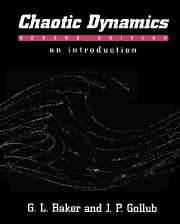Book contents
- Frontmatter
- Contents
- Preface
- Acknowledgments
- CHAPTER ONE Introduction
- CHAPTER TWO Some helpful tools
- CHAPTER THREE Visualization of the pendulum's dynamics
- CHAPTER FOUR Toward an understanding of chaos
- CHAPTER FIVE The characterization of chaotic attractors
- CHAPTER SIX Experimental characterization, prediction, and modification of chaotic states
- CHAPTER SEVEN Chaos broadly applied
- Further reading
- Appendix A Numerical integration – Runge–Kutta method
- Appendix B Computer program listings
- Appendix C Solutions to selected problems
- References
- Index
- Diskette order information
Appendix B - Computer program listings
Published online by Cambridge University Press: 05 June 2012
- Frontmatter
- Contents
- Preface
- Acknowledgments
- CHAPTER ONE Introduction
- CHAPTER TWO Some helpful tools
- CHAPTER THREE Visualization of the pendulum's dynamics
- CHAPTER FOUR Toward an understanding of chaos
- CHAPTER FIVE The characterization of chaotic attractors
- CHAPTER SIX Experimental characterization, prediction, and modification of chaotic states
- CHAPTER SEVEN Chaos broadly applied
- Further reading
- Appendix A Numerical integration – Runge–Kutta method
- Appendix B Computer program listings
- Appendix C Solutions to selected problems
- References
- Index
- Diskette order information
Summary
This appendix provides listings which may be used in their present or modified versions for exercises in the text. The listings are in the language True BASICtm and their implementation requires the use of the True BASICtm Language System together with the True BASICtm toolkits for scientific and 3D graphics. These are available from True BASIC Inc., 12 Commerce Ave., West Lebanon, NH 03784, USA. The language system may be used to run or modify the programs. Hardware requirements include an IBM compatible machine with 512K of memory, and a Hercules, CGA, EGA, or VGA graphics adaptor. A math coprocessor is highly desirable. These programs and some others are also available bound in an executable, menu-driven, self-contained software package from one of the authors (GLB) as indicated under ‘diskette order information’.
The programs are of three types: those which solve the differential equations of the pendulum, those which iterate discrete maps, and those which analyse experimental data. (The last group requires the data file found on the above mentioned software package.) Because the Runge–Kutta algorithm is complex, the computer processing time for differential equations solutions is much longer than for the iteration of maps. The reader is warned that a few of the text diagrams took many hours to produce even with a 486 IBM compatible machine.
The computer exercises of Chapter 2 are based upon the programs, PENDULUM, POINCARE, and EXPFFT. PENDULUM, Listing 1, provides a two-dimensional phase plane representation of the pendulum. The differential equation is that of the nonlinear, damped, driven pendulum.
- Type
- Chapter
- Information
- Chaotic DynamicsAn Introduction, pp. 196 - 241Publisher: Cambridge University PressPrint publication year: 1996



